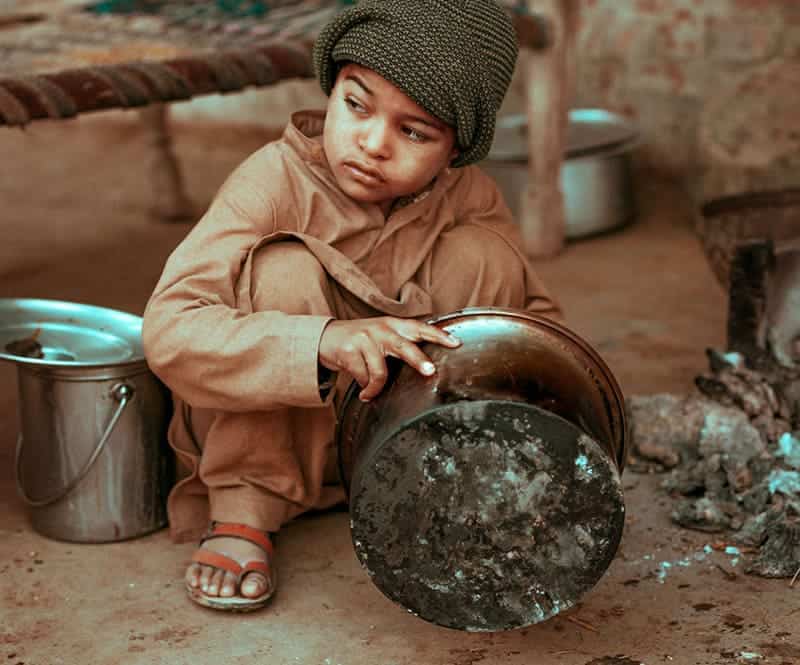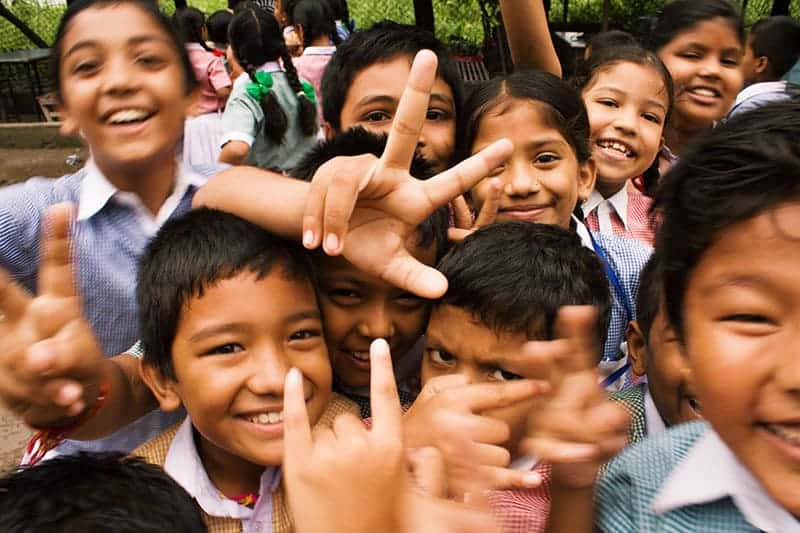The World hunger belongs to the biggest problems of our time. Famine is a global societal problem that is exacerbated by environmental problems created by other societal problems. This or something similar could be used to describe why 1.3 billion tons of food end up in the garbage can every year worldwide, even though there are also 815 million hungry people on earth at the same time.₁
In this article I want to give you everything you need to know about world hunger. You will learn the definition, statistics, causes, consequences and also the solutions that you can implement in everyday life.
Here is another short Table of contents about the article:
What does world hunger mean?
World hunger is basically the global problem of people suffering from malnutrition and undernourishment due to a lack of food.
But hunger can be divided into three different types₂, which I would like to explain to you briefly here:
- Acute hunger: This refers to a famine over a limited period of time. (e.g. as a result of wars or natural disasters).
- Chronic hunger: Means the permanent state of malnutrition in which the body takes in less food than it needs. (e.g. due to permanently poor income conditions).
- Hidden Hunger: This form of hunger is chronic, but it is difficult to recognize. The hidden hunger means a lack of nutrients due to a permanently one-sided diet. (e.g. rice as the only source of food).
Facts, figures & statistics on world hunger
Of course, I would like to back up my comments on world hunger with facts & figures. Therefore, here you will find some of the most important statistics about world hunger:
- Every ten seconds, a child under the age of 5 dies as a result of hunger.₃
- More than 800 million people go hungry, 2 billion suffer from malnutrition.₄
- About 124 million people suffer from acute hunger.₅
- Around 151 million children worldwide have growth delays.₆
- One in 9 people does not have the minimum required amount of food available.₇
- From the year 2003 to the year 2015, the percentage of hungry people in the world population has gradually decreased from 14.9% to 10.6%.₈
- The absolute number of hungry people was also steadily reduced from 2003 to 2014. From an initial 941.7 million people to 775.4 million people in 2014.₉
- Around 11% of the world's population suffered from hunger in 2016.₁₀
For more statistics on world hunger, updated annually, see the World Hunger Index or Global Hunger Index.
Tip: At World hunger statistics I have compiled many more facts and figures about the global famine.
Causes of world hunger

The reasons for global hunger are incredibly diverse. They are ecological, social and economic in nature. But one thing unites all causes - they are a consequence of human actions. Here I would like to briefly explain the main reasons for world hunger.
World hunger due to meat consumption & factory farming
According to the BMEL, 61.8% of the cereals in Germany alone are used for animal feed₁₁ and not for feeding the growing world population. The Federal Environment Agency confirms that global meat consumption has tripled since 1970. Per capita consumption in industrialized countries is at 82 kg per year.₁₂
Due to increased, agricultural emissions of greenhouse gases such as CO2 and methane, global warming is also increasing, which in turn is causing serious crop failures. World hunger is also caused by the diet in industrialized countries.
Tip: You can also learn more in the article about Factory farming.
World hunger due to wars & conflicts
Social and political conflicts or wars often lead to acute famine. For example, because technical facilities for irrigating fields are destroyed or people lose their lose personal property. The more publicly these conflicts are fought out, the greater their impact on the economy. Increased prices for less available food are often the result.
Global famine due to natural disasters
Storms, droughts and floods for example, cause unexpected but extreme crop failures. There were natural disasters in the past, too, of course. But in the wake of global warming, the number of global, climate-related disasters has tripled again since 1980.₁₃ In combination with the lack of water, long periods of drought that occur in several years in a row can become an existential and life-threatening danger.
Unequal distribution of purchasing power & food (world trade + inequality).
Not everyone has the same financial opportunities about 1% of the world's population owns about 50% of the global wealth.₁₄
In addition, the rich industrialized countries determined the rules of trade. Many developing countries export raw materials and food, but it is the importing countries that really earn money from it. Finally, at this point, corruption and illegal land grabbing also play a decisive role in global hunger.
Another cause of world hunger is the poverty of many people in developing but also industrialized countries. They simply lack the financial means to provide for their own nutrition and health.
High standard of living in industrialized countries
One of the reasons that more than 800 million people worldwide go hungry is because of the lack of appreciation of Western society for natural resources. Since everything is available to us at any time or can be ordered online, we have become a truly throwaway society. This also applies to other consumer goods, but of course especially to food waste. Around 1.3 billion tons of edible food are thrown away worldwide every year.
The same applies to the direct but above all also indirect (virtual) water consumption that results from our society's consumption mania. For example, the production of 1 kg of meat requires about 15,500 liters of water.₁₅
World hunger due to climate change and other environmental problems
The climate change exacerbates the societal problem of world hunger, as it leads, for example, to crop failures due to prolonged periods of drought. With global water scarcity, global warming is also exacerbating one of the biggest environmental problems of our time.
But of course, climate change is in turn a consequence of others, man-made circumstances on earth. Here are two examples:
- Deforestation: Rainforests are being cleared for the cultivation of palm oil plantations and cattle feed, for example.
- Overfishing of the seas: As demand for fish increases, 93% of the world's fish stocks are already considered overfished or maximally exploited.₁₆ Stocks can no longer recover quickly and food shortages are occurring.
These and many other causes of food shortages are thus closely interrelated.
Growth of the world population
Often, the rising number of the world's population feels like a general excuse for not being able to do anything about world hunger as an individual. The reality is that the World population increases by about 2-3 people per second₁₇ - and this increase must be supplied with food, drinking water and many other things. Nevertheless, according to the UN's plan, world hunger could actually come to an end by 2030 - despite a sharply rising global population. This is because the food situation is primarily a problem of distribution (see food waste) and the diets (increasing demand for meat) of our society.
What are the consequences of global famine?

In Article 11 of the UN Social Covenant, the Right to food firmly anchored as a human right. Nevertheless, nearly one billion people on earth suffer from famine. This suffering has extreme social, economic and health consequences. Here I would like to explain them to you in more detail.
Children get into a vicious circle
Hunger and poverty are related to many other problems in life. Parents who suffer from hunger themselves are physically weakened and become ill more easily. As a result, the labor force suffers and they cannot afford to send their children to school. Often the children even have to work themselves. But even if they can go to school, the malnutrition causes them to be unfocused and their educational level suffers. The resulting dwindling job opportunities ultimately mean that they also have a poorer income later on and could also face famine in the future.
Economic power of a company decreases
A logical consequence of a starving society is also the decline of the country's own economic power - especially in developing countries.
When people are physically weaker and become ill more often as well as for longer periods of time, then their productivity also suffers. As a result, fewer goods can be produced to supply citizens, making costly imports necessary or increasing dependence on development aid from rich industrialized countries.
People flee their home countries
When industrialized countries provide humanitarian aid in crisis situations, this measure addresses the symptom in the short term, but not the causes of world hunger in the long term. When certain regions are affected by long periods of drought and extreme water scarcity, people will eventually to regions as close as possible where their chances of survival are better.
In many countries parents have many children
The desire to have more than two children is particularly strong in developing countries. On the one hand, because parents have a Protection in old age need and on the other hand because the Mortality rate among children is usually significantly higher than in industrialized countries due to poorer medical care and a lack of clean drinking water and food.₁₈
Diseases spread
Malnourished people have a weakened immune system and become ill more quickly. In addition, there is often little or contaminated drinking water available in developing countries. A lack of medical care also contributes to the fact that diseases such as diarrhea can spread more quickly.
Already in the womb, children of malnourished parents can suffer from malnutrition. The developmental delay is difficult to make up after birth under the conditions that usually prevail.₁₉
People and animals die due to famine
Physical weakness due to famine accelerates the death of people and animals. In countries like Somalia, for example, many people depend on their camels. But since these also suffer from the lack of drinking water and food supply suffer, they starve and die of thirst. The death of the animals then also deprives many owners of their own livelihood.
How can we fight world hunger?

To actually defeat world hunger by the year 2030 will only work in harmony between consumers, business and politics. Here I would like to show you what you can do yourself in everyday life against world hunger and which measures politics & economy have to implement against the global suffering from hunger.
What everyone can do in everyday life
Many people contribute massively to the fact that people elsewhere have to starve through their lifestyle. Here I would like to show you how you can counteract world hunger daily and relatively uncomplicated.
Tip: In the article Stop world hungerI have described all the everyday tips in more detail.
Vegan or vegetarian diet
To what extent does it affect world hunger if I were to give up meat or products of animal origin altogether? Quite simply, if all people were to give up meat, there would be, for example suddenly millions of square meters of land available for the cultivation of plant foods. In addition, emissions of greenhouse gases (such as CO2 or methane) and global water consumption would be drastically reduced. By giving up meat, our society would also live even healthier, so that diseases such as diabetes or high blood pressure would decline.₂₀
Learn in the article Become a vegetarianhow to get a really easy start to your dietary change.
Notice: Of course, this also applies to abstaining from fish and seafood. Because when the ecosystem can recover, we counteract the Overfishing of the seas so that fish stocks can recover and people in poor coastal areas in particular can find more food.
Reduce food waste
As described at the outset, around 1.3 billion tons of food are wasted every year, even though 815 million people go hungry at the same time. Through a respectful and wise handling of the foodavailable to us, we can counteract world hunger. Here are some practical tips for implementation:
- Sort older foods to the front of the refrigerator.
- Buy also times crooked food, because otherwise they are usually thrown away.
- Buy only the food you really want and can eat.
- Use Beeswax wipes, to keep food fresh longer.
In a separate article you will also learn how to Making food last longer can. I also recommend that you share leftover food with others. Both with your neighbors and with organizations like Food Sharing. With the latter you can even get and save food for your own use for free.
Regional & seasonal and conscious shopping
Focus your purchases on fair trade, seasonal, and regional Organic food. You can recognize them, for example, by the organic or FairTrade seal or the country of origin. Through FairTrade you support, for example, the farmers who are not from industrial agriculture and now still receive fair prices. For example, do not buy oranges from Spain. These are irrigated with groundwater, and about 438 liters of water are needed for one kilogram of oranges.₂₁ You don't use this water directly, but indirectly. In the article about the Environmental problem of water scarcity you can learn more about it.
Donations to fight world hunger
In addition to a change in lifestyle, of course, a donation to the OrganizationsThe aim is to fight the causes of world hunger and to support people in famine. I have listed and briefly explained three useful starting points here:
- Welthungerhilfe: The organization is committed to ensuring that every person can live a self-determined life without hunger and poverty in the future. For example, it promotes local agriculture and access to clean drinking water. More under www.welthungerhilfe.de.
- UNICEF: The United Nations Children's Fund fights to ensure that girls and boys around the world can grow up healthy and safe. For example, malnourished children in famine are provided with special food. More at www.unicef.de.
- Bread for the World: The Development Agency of the Protestant churches supports people in rural regions worldwide in achieving higher agricultural yields. It also provides targeted support for education and health, among other things. More at www.brot-fuer-die-welt.de.
Tip: Besides private donations you can of course also donate to change.org or other petition portals to start an action against a specific grievance and collect signatures. Get personally involved in the fight against world hunger.
What politics & business must do

Of course, we consumers can do our part to solve world hunger. However, this attentiveness will have little effect if the economy and politics do not also counteract this social problem with full force.
Here are some Ideas, goals and measuresthat can contribute to solving world hunger:
- Permanent access to education and employment for refugees
- Pushing the 2030 Zero Hunger Goal
- Allow rescue of food from supermarket containers
- Expansion of infrastructure and markets in rural areas
- Training programs for smallholder farmers in developing countries
- Actively combat causes of flight such as climate change, hunger & conflicts
What else needs to be done? If you have more ideas, feel free to add them in the comments below this post.
Will global hunger end?
Yes, it will. But until then, countless people and animals will die from famine, spreading diseases and lack of water. I think this report from Somalia makes it clear to each of us how serious the situation is. And that everyone who daily three liters of water and has two to three hot meals available, appreciates this situation.
You can't build a peaceful world on empty stomachs and human misery.
Dr. Norman Ernest Borlaug
Since many of us are in the financial as well as physical position to do so, we should do our best to support people in famine.
I hope this article on world hunger has given you a sense of the gravity and urgency of the situation. Through our lifestyles, we are all part of the problem, but we may as well all be part of the solution every day. Do you have any questions, tips, or experiences of your own you'd like to share? If so, feel free to post a comment. Feel free to share this post to educate as many people as possible.

PS.: Have a look at our Environmental protection blog by. There you'll learn even more about social and environmental issues. Learn, for example, how you can help the global species extinction of animals and plants.
References:
₁ https://www.welthungerhilfe.de/aktuelles/blog/lebensmittelverschwendung
₂,₃,₄,₇,₁₀,₁₉ Deutsche Welthungerhilfe e. V.: HUNGER: DISTRIBUTION, CAUSES & CONSEQUENCES, available at https://www.welthungerhilfe.de/hunger. [28.03.2020].
₅,₆ https://www.globalhungerindex.org/de
₈,₉ https://de.wikipedia.org/wiki/Welternährungsprogramm_der_Vereinten_Nationen#Hungernde_weltweit
₁₁ https://www.moderne-landwirtschaft.de/fressen-die-tiere-uns-das-getreide-weg
₁₂ https://albert-schweitzer-stiftung.de/aktuell/umweltbundesamt-zum-zusammenhang-von-fleischkonsum-und-welthunger
₁₃ https://www.nationalgeographic.de/7-fakten-zum-klimawandel
₁₄ https://www.heise.de/tp/features/Die-reichsten-1-Prozent-besitzen-mehr-als-50-Prozent-des-globalen-Vermoegens-3890296.html
₁₅ https://waterfootprint.org/media/downloads/Hoekstra_and_Chapagain_2006.pdf
₁₆ https://www.wwf.de/themen-projekte/meere-kuesten/fischerei/ueberfischung
₁₇ https://www.br.de/themen/wissen/weltbevoelkerung-bevoelkerungswachstum-menschen-erde-welt-100.html
₁₈ https://www.dsw.org/bevoelkerungswachstum-3-warum-waechst-die-weltbevoelkerung
₂₀ https://www.welt.de/kmpkt/article171128188/Das-wuerde-passieren-wenn-wir-alle-sofort-aufhoeren-wuerden-Fleisch-zu-essen.html
₂₁ https://www.naturfreunde.de/sites/default/files/attachments/nf_vw_methodenkoffer_leitfaden_final_website_1.pdf





